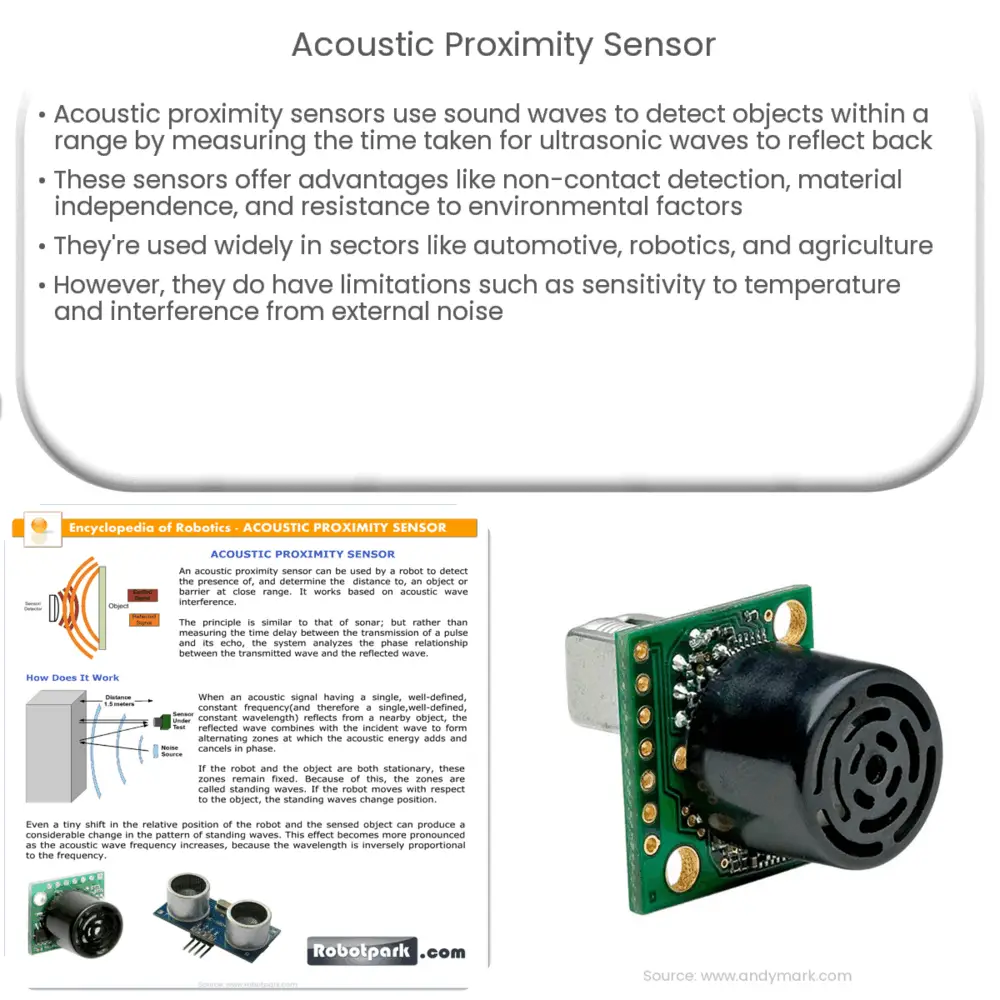Acoustic proximity sensors detect objects using ultrasonic waves, offering non-contact detection, material independence, and high accuracy.

Acoustic Proximity Sensor: A Comprehensive Guide
In recent years, advancements in sensing technology have led to the development of various proximity sensors, each with their own unique set of advantages and applications. One such sensor that has garnered significant attention is the acoustic proximity sensor. In this article, we will explore the fundamentals of this technology, its working principle, advantages, and potential applications.
Understanding Acoustic Proximity Sensors
Acoustic proximity sensors, as the name suggests, rely on sound waves to detect the presence of an object within a specific range. These sensors emit ultrasonic waves and measure the time it takes for the waves to reflect off an object and return to the sensor. By calculating the time it takes for the sound waves to travel back and forth, the sensor can determine the distance between itself and the object.
Working Principle
The core components of an acoustic proximity sensor include a transmitter, a receiver, and a control circuit. The transmitter generates ultrasonic waves, which travel through the air and reflect off nearby objects. These reflected waves are then captured by the receiver, and the control circuit processes the time delay between the transmitted and received waves to determine the object’s distance.
Typically, acoustic proximity sensors use the following equation to calculate distance:
Distance = (Speed of Sound x Time Delay) / 2
Dividing by 2 is necessary because the sound waves travel to the object and back, so the actual distance is half the total distance traveled by the waves.
Advantages of Acoustic Proximity Sensors
Acoustic proximity sensors offer several advantages over other types of proximity sensors, including:
- Non-contact detection: Since these sensors rely on sound waves, they can detect objects without making physical contact. This makes them suitable for applications involving delicate or fragile materials.
- Material independence: Acoustic proximity sensors can detect a wide range of materials, including metal, plastic, glass, and even liquids, as long as the surface of the object can effectively reflect ultrasonic waves.
- Resistance to environmental factors: These sensors are largely unaffected by environmental factors such as dust, dirt, and moisture, making them suitable for use in harsh or challenging conditions.
- High accuracy: Acoustic proximity sensors can provide accurate distance measurements, often within millimeters, making them ideal for precise positioning and measurement tasks.
Applications of Acoustic Proximity Sensors
Thanks to their unique advantages, acoustic proximity sensors find applications in a wide range of industries and scenarios. Some common uses include:
- Automotive industry: parking assistance systems, blind-spot detection, and collision avoidance
- Robotics: object detection and navigation for autonomous robots
- Industrial automation: material handling, level sensing, and quality control
- Agriculture: monitoring crop growth and irrigation systems
- Medical devices: fluid level sensing and flow rate monitoring
Types of Acoustic Proximity Sensors
There are several types of acoustic proximity sensors available on the market, each with its own set of characteristics and suited for specific applications. Some of the most common types include:
- Ultrasonic through-beam sensors: These sensors consist of a separate transmitter and receiver. The transmitter emits ultrasonic waves, while the receiver detects the waves on the other side. An object that breaks the beam will cause a reduction in signal strength, triggering the sensor.
- Ultrasonic retro-reflective sensors: These sensors use a single unit for both transmission and reception of ultrasonic waves. A separate reflector is placed opposite the sensor, and when an object comes between the sensor and the reflector, it alters the reflected signal, triggering the sensor.
- Ultrasonic diffuse sensors: Similar to retro-reflective sensors, these sensors have a combined transmitter and receiver in a single unit. However, they do not require a separate reflector, as they rely on the natural reflection of sound waves off the detected object.
Limitations of Acoustic Proximity Sensors
Despite their many advantages, acoustic proximity sensors also have some limitations that must be considered when selecting the appropriate sensor for a given application:
- Sensitivity to temperature: Changes in temperature can affect the speed of sound, which may cause inaccurate distance measurements. Some sensors come with built-in temperature compensation to mitigate this issue.
- Limitations with soft or absorbent materials: Acoustic proximity sensors may struggle to detect objects made of soft or absorbent materials, as they can absorb the sound waves instead of reflecting them back to the sensor.
- Interference from external noise: In environments with high levels of ambient noise, the sensor’s ability to accurately detect objects may be compromised. Some sensors use frequency modulation techniques to minimize this interference.
- Narrow sensing range: Acoustic proximity sensors typically have a limited sensing range compared to other types of sensors, such as laser-based sensors. This may restrict their use in certain applications.
Conclusion
Acoustic proximity sensors are versatile and accurate sensing devices that rely on the reflection of sound waves to detect objects. They offer numerous advantages, such as non-contact detection, material independence, and resistance to environmental factors. These sensors are used in various industries, including automotive, robotics, industrial automation, agriculture, and medical devices. While they do have some limitations, their benefits make them an attractive choice for many applications. As technology continues to advance, we can expect to see even more innovative and efficient acoustic proximity sensor solutions in the future.

